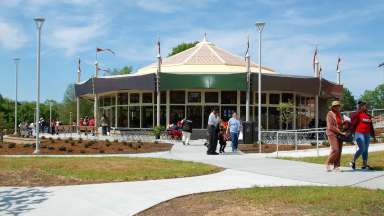John Chavis was born in either 1762 or 1763 to parents who were legally free during the era of slavery. Scholars have debated his birthplace, although two places in North Carolina, Pitt County and Granville County, show evidence that he was born in the Tar Heel state. Little is documented of his early life, and stories differ as to how John Chavis was educated. However, one part of his life remains clear. John Chavis was a deeply religious man. One story suggests that he studied under John Witherspoon, a signer of the Declaration of Independence and president of the College of New Jersey. A scholar of Greek and Latin, Chavis attended what is now called Washington and Lee University, graduating with honors in 1801. He attracted public attention because his academic record contradicted the widely-held belief that African Americans were intellectually inferior to whites. "Intellectually he was inferior to few North Carolinians," said historian John Hope Franklin. During the antebellum period, John Chavis was the most prominent free African American in North Carolina and was considered probably the most learned African American man in the United States. John Chavis fought in our nation's struggle for independence as a soldier in the Fifth Regiment of Virginia. Enlisting in December 1778, he served three years in the Revolutionary War. He was identified as a free African American and as the owner of one horse in the 1789 tax list of Mecklenburg County, Virginia. John and his wife, Sarah Frances Anderson, had one son, Anderson Chavis.
In 1799, Chavis was licensed to preach and served as a missionary for the General Assembly of the Presbyterian Church to slaves in Maryland, Virginia, and North Carolina. In 1807, Chavis traveled to Raleigh and preached to African American and white congregations in Granville, Orange, and Wake Counties. Unfortunately, his preaching days abruptly ended in 1832, after Nat Turner's Rebellion. Nat Turner was an educated slave and preacher in Virginia who led a bloody insurrection ending in the murder of dozens of whites. Because of this rebellion, slaveholding states enacted laws forbidding African Americans to preach.
John Chavis was an educator as well as a preacher. He taught full-time following the ruling banning African Americans from preaching. John Chavis taught both races together in a school he opened in his home until white parents objected. Then he taught white children during the day for $2.50 per quarter and African American children in the evenings charging them $1.75 per quarter. Chavis' influence on African Americans and whites was far reaching. Running a school for free African Americans for thirty years, John Chavis did all he could to prepare free African American children to face the challenges of the 1830s. His school was considered one of the best in the state -- either African American or white -- and he taught the children of some of the most powerful men in white society. North Carolina Whig Senator Willie P. Mangum, North Carolina Governor Charles Manly, and New Mexico Governor Abram Rencher were among the more notable white students that he taught.
John Chavis died in 1838. The circumstances surrounding his death are unclear. However, many suspect that he was murdered because of his work to better the lives of African Americans. John Chavis' contributions to Raleigh were memorialized when the Chavis Height apartments and Chavis Park were named in his honor in 1938. John Chavis' influence on both whites and African Americans as a preacher as well as a teacher was far reaching. Few free African Americans in the South equaled John Chavis in literacy or financial status. He was a dedicated opponent of slavery as well as an influential civil rights leader in the South.

